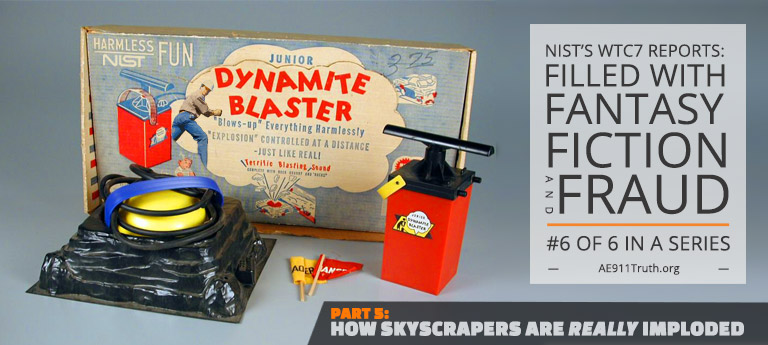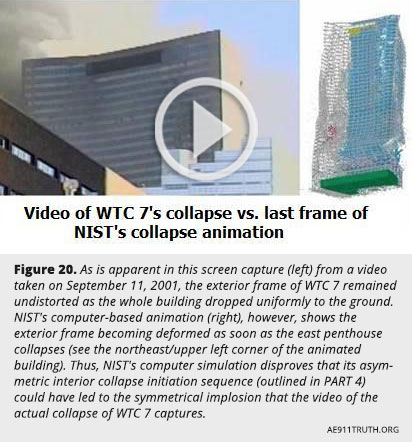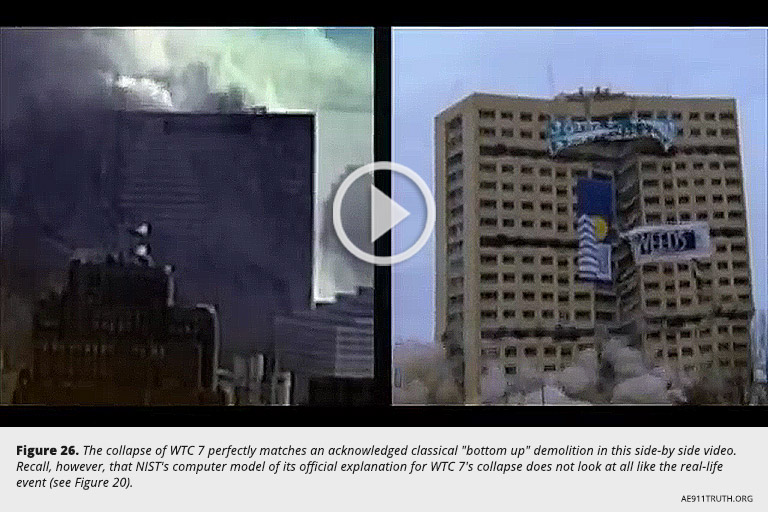NIST's official "normal office fire" explanation for the collapse of World Trade Center Building 7 does not explain the 47-story tower's stunning implosion and free-fall acceleration. That's because NIST has ignored the data that does explain these extraordinary features — the evidence of controlled demolition.
PART 5: How Skyscrapers Are Really Imploded
By Simon Falkner and Chris Sarns
Editor's Note: This fascinating and provocative technical article on NIST’s mistreatment of the World Trade Center Building 7 evidence is broken down into a series of six articles. The sixth and final installment, below, is PART 5: How Skyscrapers Are Really Imploded. The first installment was the INTRODUCTION. The second installment was PART 1: NIST and Popular Mechanics Fabricate Myth About WTC 7's "Scooped-Out" 10 Stories. The third installment was PART 2: NIST's Fictitious Gouge Launches Design Flaw Myth and Collapse Initiation Theory. The fourth installment was PART 3: Trusses & Tanks—Popular Mechanics Helps NIST Create More Myths. The fifth installment was PART 4: Independent Analysis Disproves NIST's New Thermal Expansion Hypothesis.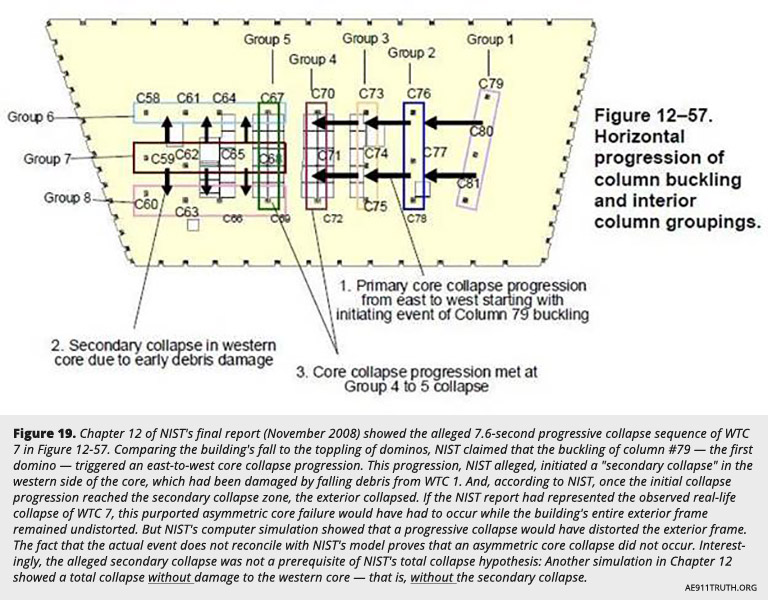
In PART 4, we demonstrated that NIST's hypothetical girder walk-off event contradicted its own data, and therefore that NIST's column #79 buckling scenario could not have happened. Thus, we proved that NIST had no evidence upon which to base its claim of how the collapse of WTC 7 was triggered.
Now let us ask: Did NIST's explanation of how this initiating event led to the observed collapse of the entire building also contradict its own data? The short answer: "Yes."
For a more detailed answer, we must first assume, for the sake of argument, that column #79 buckled and that this event did lead to NIST's hypothesis for how the complete collapse of WTC 7 occurred. NIST presumed that a localized collapse of the northeast section of the building set off a progressive collapse of the core, and that this 7.6-second core collapse sequence (see NIST's time line) occurred while the building's exterior remained undistorted. Specifically, NIST claimed that the buckling of core column #79 led to the subsequent buckling of columns 80 and 81, then to the collapse of the east penthouse, and finally to the failure of the entire core (see Figure 19).
NIST's presumption leaves us with this obvious question: Did the hypothetical progressive core collapse match the distinguishing features of the observed implosion of WTC 7?
The answer is a resounding "No," according to more than 2,350 architects and engineers and hundreds of other building professionals and physical scientists who belong to AE911Truth. In their expert eyes, NIST's computer simulation proved that WTC 7 most certainly did not collapse according to NIST's hypothetical progressive collapse scenario.
NIST's computer simulation of its progressive collapse sequence does not remotely resemble the actual collapse of WTC 7. Instead, its simulation exposes fundamental flaws in the progressive total collapse hypothesis. In particular, the computer simulated collapse sequence shows three glaring contradictions which, when compared to the real event, prove that a progressive collapse did not occur:
#1. The exterior would not remain undeformed during progressive core collapse
WTC 7's perimeter frame could not have remained virtually undeformed — as the Figure 20 video of the actual collapse proves was the case — during the 7.6-second progressive core collapse that NIST alleges. NIST's simulation of its progressive collapse shows the exterior deforming as soon as the east penthouse caves in. It also has the whole building twisting and deforming, in stark contrast to the real-life event (see Figures 20 and 21). NIST's contention that its alleged progressive collapse sequence explains the actual collapse of WTC 7 is, therefore, demonstrably false.
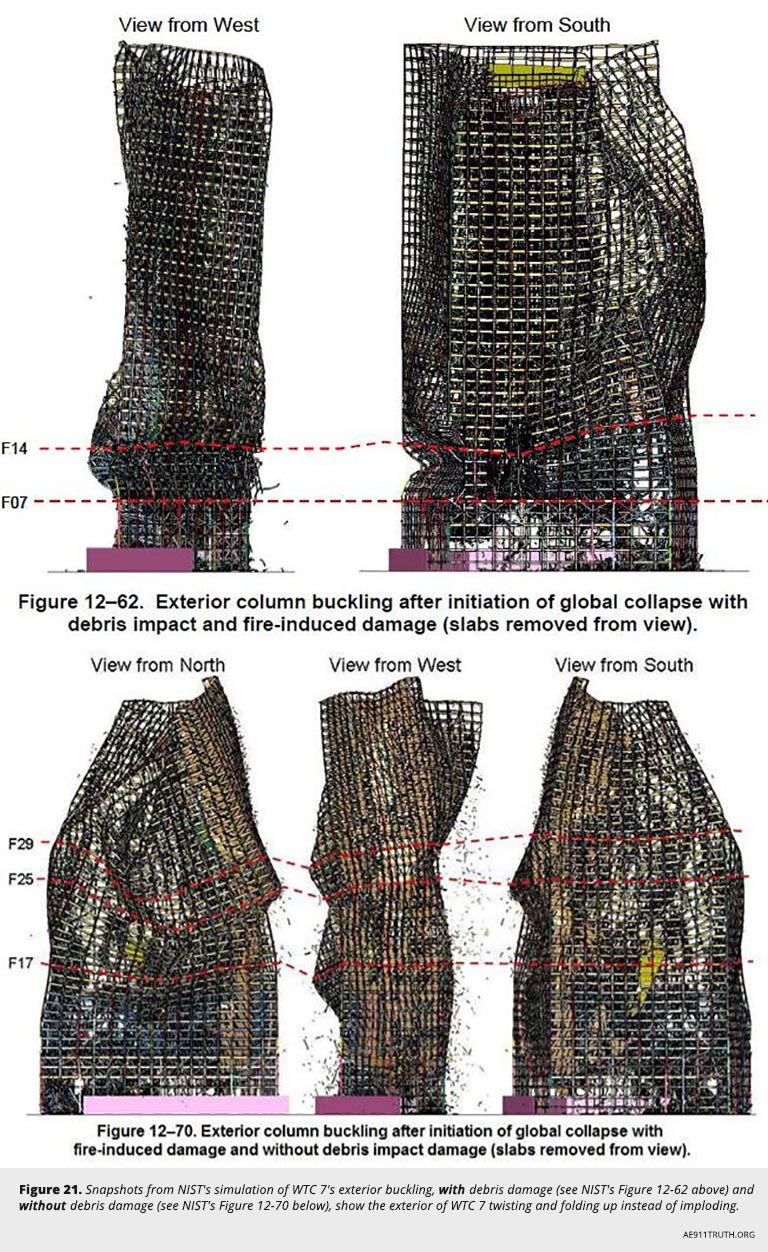
#2. A progressive core collapse would lead to an asymmetric fall instead of symmetric implosion
The actual videos of WTC 7's collapse show it falling symmetrically — straight down into its own footprint. To the eye of experts in controlled demolition, the collapse has all the hallmarks of an implosion. However, the alleged progressive core collapse claimed by NIST would have led to an asymmetric fall, not a symmetric implosion. Curiously, NIST stopped its animated simulation just after one second into the sequence of the 6.6-second global collapse, just as the folding-up motion on the bottom south side of the building's external frame became more acute (see Figure 20). Yet there was no legitimate excuse, scientific or otherwise, for NIST not to show the complete animation from start to finish. Was NIST purposely hiding the fact that, had the simulation continued, it would have showed the entire building twisting and folding up instead of imploding, as video snapshots (see Figure 21) show?
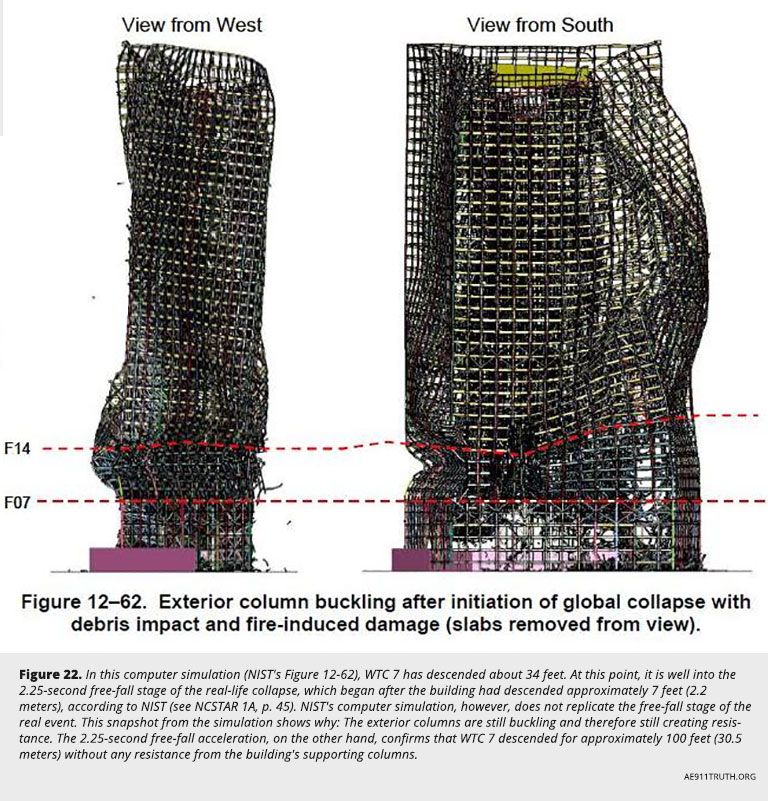
#3. The progressive core collapse sequence does not replicate observed free-fall acceleration

"A free fall time would be an object that has no structural components below it . . . . [T]here was structural resistance that was provided in this particular case. And you had a sequence of structural failures that had to take place. Everything was not instantaneous." — NIST's lead investigator Shyam Sunder in his "WTC 7 Technical Briefing" of August 26, 2008
NIST's final draft for public comment in August 2008 denied that WTC 7 experienced free-fall acceleration during its collapse. Lead investigator Shyam Sunder explained in the Q&A period of NIST's "WTC Technical Briefing" that free fall would be impossible, because it would imply zero structural resistance by the 82 support columns (see quote above).
As a result of the forensic investigative work of physics teacher David Chandler, however, NIST was forced to admit in its November 2008 final report that there was indeed 2.25 seconds of free fall, during which time 100 feet, or eight stories, of WTC 7 collapsed. This meant that the entire steel supporting structure of eight floors had "vanished," which we all know is impossible — without the assistance of incendiaries and/or explosives. Unaccountably, NIST ignored the significance of the free-fall finding. And it never provided a credible explanation of how its "normal office fire"-based narrative could lead to the 6.6-second symmetrical collapse of WTC 7.

When taken together, the three contradictions outlined above clearly prove that the destruction of WTC 7 did not happen in the way NIST claims it did.
NIST's computer simulation proves that WTC 7's exterior could not have remained virtually undeformed during a progressive collapse of its core. Yet videos of WTC 7's collapse show that its exterior did remain virtually undeformed until the moment the whole structure started to fall uniformly to the ground. Thus, we know without a doubt that NIST's progressive core collapse scenario is neither plausible nor possible.
Of even more importance is the fact that NIST's simulation fails to replicate the two most prominent and unusual features of the collapse of WTC 7: the stunning 2.25 seconds of free-fall acceleration and the observed symmetrical implosion of the building. The 2.25 seconds of free fall tells us that approximately eight floors of the building's supporting structure were completely "removed." The symmetry tells us that their removal happened practically simultaneously.
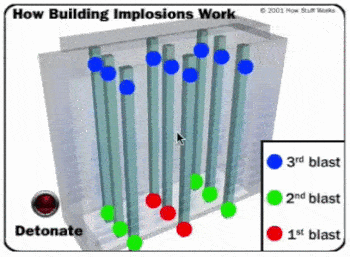
A "normal office fire" cannot cause a fireproofed steel frame to "vanish" in an instant. Incendiaries and explosives can. Symmetrically razing a steel-framed skyscraper in mere seconds, though, requires such extraordinary demolition skills that only a handful companies in the world will even attempt it (see Figure 24). Thus, the visual evidence remains uncontested. It is prima facie proof of the controlled demolition of WTC 7.
When reading this series, you have probably noticed how unscientific and false NIST's explanations have been. Now you will see that NIST has also ignored a plethora of crucial evidence that points to a radically different conclusion.
 "Did they actually use the word 'brought down' and who was it that was telling you this? The fire department, and they actually did use the word 'We're going to have to bring it down.'"
"Did they actually use the word 'brought down' and who was it that was telling you this? The fire department, and they actually did use the word 'We're going to have to bring it down.'"
"He takes his hand off and you hear '3, 2, 1, and it was boom, boom, boom, boom, boom.'"
"And the whole time you're hearing, 'THOOM! THOOM! THOOM! THOOM! THOOM!' I think I know an explosion when I hear it."
— 9/11 First Responders
Witness testimonies and Chandler's forensic research corroborate the visual evidence. First-hand observers saw and heard the classic symptoms of a controlled demolition — explosions. After the collapses of the Twin Towers, the rumor spread that WTC 7 would be the next to go down. Some witnesses said they were specifically told that the building would be taken down. One first responder reported hearing a controlled demolition-style countdown just before the building collapsed; others confirmed that the collapse sounded like a controlled demolition (see quotes above). Thus, from that afternoon on, it was clear that engineers investigating the destroyed WTC 7 would — or at least should — be tasked with determining and explaining how the 47-story tower was intentionally demolished.
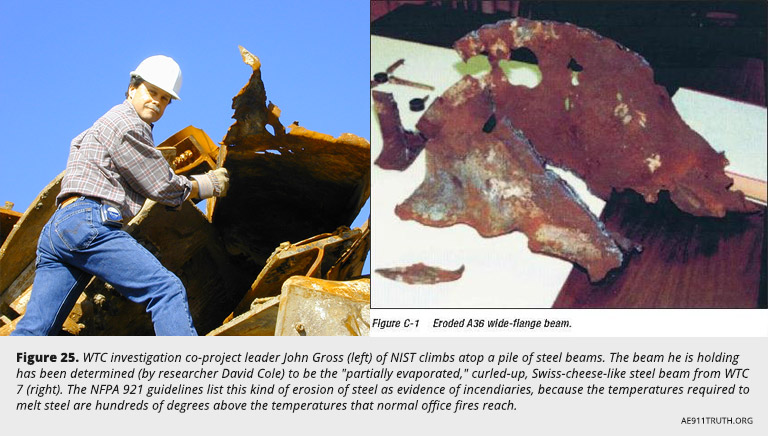
Finally, since NIST did not adhere to the National Fire Protection Association (NFPA) 921 investigative guidelines, let's do what NIST should have done — explore what kind of data is considered by the NFPA 921 as evidence of incendiaries and explosives, or, in this case, forensic evidence for controlled demolition.

"Mixtures of fuels and Class 3 or Class 4 oxidizers may produce an exceedingly hot fire and may be used to start or accelerate a fire. Thermite mixtures also produce exceedingly hot fires. Such accelerants generally leave residues that may be visually or chemically identifiable. . . . Indicators of exotic accelerants include . . . melted steel or concrete." — NFPA 921: 19.2.4 — Exotic Accelerants
The NFPA 921 has a special section on incendiary evidence. It explains that the presence of melted steel or concrete gives investigators a clue that thermite-type materials may have been used (see quote directly above). Traditional thermite materials can be configured into cutter charges that can slice through steel columns. Sophisticated patented devices were available prior to 2001. Modern variants can be made to be more explosive. NIST would have known all about the potential of thermitic materials. After all, some NIST employees and contractors who investigated the WTC collapses had helped develop those modern variants, as this article by Kevin Ryan explains.
Is there evidence that molten steel and/or molten concrete was present on 9/11? Yes, witnesses and physical evidence confirm the existence of both molten substances. Yet engineer John Gross, co-project leader of NIST's investigation, dared in a public meeting to deny the existence of this evidence, even though it seems he saw — and held — pieces of it (see Figure 25). Melted iron/steel was discovered under the rubble of WTC 1, WTC 2, and WTC 7. And billions of previously melted iron-based microspheres were found in the WTC dust. Some steel beams that were recovered from WTC 7 showed a unique, curled-up, Swiss-cheese appearance, indicating they may have been "partially evaporated" by an extremely high temperature sulfidation reaction, which happens to coincide with a thermite variant known as thermate. Previously melted concrete was also found in the rubble. And as if that weren't enough, still other evidence strongly suggested that thermitic materials had played a part in bringing down WTC 7. Videos that show side-by-side comparisons of the implosion of WTC 7 and an acknowledged professional demolition also support the contention that WTC 7 was professionally demolished (for example, see Figure 26).
Witness testimonies, visual evidence, and forensic evidence all point to the same conclusion: WTC 7 was imploded by a controlled demolition via incendiaries and explosives.
NIST, on the other hand, has offered no evidence to support its scenario of "normal office fire" initiating WTC 7's collapse. In fact, NIST's computer simulation disproves its own case.
It's troubling to contemplate the extent to which NIST went in omitting and distorting data in order to fabricate its illogical collapse initiation hypothesis, which we outlined in PART 4. It's equally disconcerting to uncover, as we have in this section, proof that NIST misrepresented or ignored actual evidence in order to assiduously avoid the logical conclusion of controlled demolition. According to the National Science Foundation, these sorts of omissions and distortions rise to the level of scientific misconduct or worse.
Danny Jowenko, a Dutch controlled demolitions expert, first saw a clip of WTC 7 collapsing in 2006, when a filmmaker showed it to him during an interview in The Netherlands. "This is a controlled demolition," Jowenko declared without hesitating. "Absolutely, it's been imploded." Having no ties to the US government or to US business interests may have given him the freedom to courageously speak his mind. Meanwhile, Americans with the same expertise have had good reason to stay silent on the subject: major federal contracts.
All in all, the official version of the failure of WTC 7 does not stand up to even the most elementary scrutiny. Yet with breathtaking chutzpah, NIST and the defenders of its theory continue to ask us all, paraphrasing a Chico Marx line in the movie Duck Soup, "Who are you going to believe, me or your own lying eyes?"
How would you answer?
This is the sixth and last installment of our series of six articles, titled NIST's WTC 7 Reports: Filled with Fantasy, Fiction, and Fraud. The five previous installments may be found here: INTRODUCTION, PART 1: NIST andPopular Mechanics Fabricate Myth About WTC 7's "Scooped-Out" 10 Stories, PART 2: NIST's Fictitious Gouge Launches Design Flaw Myth and Collapse Initiation Theory, PART 3: Trusses & Tanks—Popular Mechanics Helps NIST Create More Myths, PART 4: Independent Analysis Disproves NIST's New Thermal Expansion Hypothesis.





